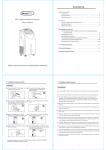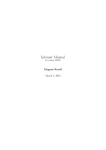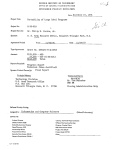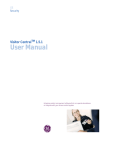Download Computing Poisson probabilities
Transcript
RESEAIEH CONlRll3UTIONS Management Science and Operations Research Harvely J. Greenberg Editor Computing Poisson Probabilities BENNETT L. FOX and PETERW. GLYNN ABSTRACT: We propose an algorithm to compute the set of individual (nonnegligible) Poisson probabilities, rigorously bound truncation error, and guarantee no overflow or underflow. Work and space requirements are modest, both proportional to the square root of the Poisson parameter. Our algorithm appears numerically stable. We know no other algorithm with all these (good) features. Our algorithm speeds generation of truncated Poisson variates and the computation of expected terminal reward in continuoustime, uniformizable Markov chains. More generally, our algorithm can be used to evaluate formulas involving Poisson probabilities. 1. INTRODUCTION We give an algorithm to compute the set of individual (nonnegligible) Poisson probabilities, needed for example in the applications pointed out in section 1.1. To get finite termination, we clearly have to truncate the Poisson distribution. Unlike previous contributions, we bound the mass in the truncated tails from above and the remaining individual probabilities from below. Given any “reasonable” E (see section 3) we find a left truncation point L and a right truncation point R such Bennett 1.. Fox’s and Engineering research Research Peter W. ~Glynn’s research under Crnnt EC%8404809 DAAG29-80-C-0041. 0 1988 ACM 440 was supported by a grant Council of Canada. from the Natural Sciences was supported by the National Science Foundation and the U.S. Army under Contract Number OOOI-0782/88/0400-0440 Communications of the ACM $1.50 that for a Poisson random variable N with parameter X we have P[L 5 N 5 R] 2 1 - E and R - L = O(A). Starting from a mode m = 1x1 we recursively compute weights w(m - l), w(m - Z), . . . , w(L) and w(m + l), w(m + 2), . . . , w(R) such that for some constant (Ywe have w(i) = ap(i) for L I i 5 R where p(i) = P[N = i], a! G W, and W = w(L) + . . . + w(R). Our (new) lower bounds let us scale the weights, via the choice of w(m), to guarantee without repeated checking that no underflows or overflows occur. Our (new) upper bounds let us avoid estimating tail masses by summing estimated probabilities in the complementary region, a computation likely to be significantly contaminated by roundoff error. As far as we know, no other published algorithms for computing Poisson probabilities use rigorous, practical bounds such as ours, and so these algorithms are unsatisfactory. Such bounds do not seem readily accessible elsewhere. The overall work and space complexities are both O(h), which lets us handle all practical X’s Our algorithm does not restrict X. Today’s desktop computers can easily handle X in the range 0 to lOlo say.. We give a crude analysis of roundoff error that suggests that our method is numerically stable. Possibly w (i)/W may underflow for some i, but this is ordinarily irrelevant if the computations are properly arranged. For (example, we can compute a weighted sum w(L)f (L) + . . . + w(R)f (R) and (only) then divide the sum by W. Likewise, the overall error in a computation is ordinarily small even though the individual estimated probabilities are all a bit off. To illustrate, we note April 1988 Volume 31 Number 4 ResearchContributions PROPOSITION 1. Let f be a real-valued function with llfll = sup(f(j): j = 0, 1, 2, . . .) and P[L 5 N 5 R] z 1 - E. In exact arithmetic, Proof. It suffices to show that cpO ] q(j) - p(j) ] I 2~ where q(i) = w(i)/W = p(i)//3 with @= p(L) + . . . + p(R). Now i I q(i) - A4 I 5 iL [4(i) - p(i)] + E j=O = igL p(i) i - 1 + E 5 2~. 0 [ I For large X, our L is X - O(h) and our R is X + O(A). This verifies that our overall work and space complexities are both O(h). In contrast, the 1982 IMSL routine asks the user to specify a parameter k-not necessarily related to X-and outputs estimates of p(O), p(l), . . . , p(k). This amounts to setting L = 0. The k specified by any reasonable user will be O(X). Thus, in practice the IMSL routine requires O(X) work. 1.1 Motivation Gross and Miller [9] and Fox [4] consider problems of this form, in which large values of X typically occur. Given the f( j)‘s, the first summation in proposition 1 can be computed in O(A) time; without the left truncation, it would take O(X) time. For the terminalreward problem considered by Gross and Miller [6], the required f( j)‘s can be computed in O(h) time using successive (matrix) squaring up to L as Fox [4] details. On the other hand, consider using the weights to compute Erlang’s loss formula (e.g., see Gross and Harris with c servers as w(c)/[w(L) + . . . + w(c)] for L 5 c zz R. If L = 0, the error is zero (ignoring roundoff and assuming no underflow occurs) but computing the weights then takes O(X) time. For L > 0 we do not attempt a formal error analysis here, which would require lower as well as upper bounds on the left tail. Our bounds may indicate a reasonable choice of R. For another example, suppose that we want to generate truncated Poisson variates by (efficientlyimplemented) inversion or by the alias method. Simply scale standard uniform variates as u c uW and then use the w (j)‘s directly. Our algorithm reduces the setup time from O(X) for a naive method (with no error bounds) to O(h) with bounds on truncation error. Fox [5] bound the loss in coverage probability for confidence intervals constructed from truncated variates with any distribution. Bratley, Fox, and Schrage [2] argue that truncation avoids statistical anomalies and allows variate generation by (efficiently-implemented) inversion in O(1) marginal time, independently of the truncation point. Inversion is compatible with common random numbers and antithetic variates, but rejection methods typically are not. April 1988 Volume 31 Number 4 1.2 Numerical Stability The w( j)‘s are slightly inaccurate due to roundoff error. They are all positive, so no cancellation errors occur when adding them to get W. Thus, the additional roundoff error induced by adding the w(j)‘s is potentially troublesome only when there are many summands (large X). If we were simply to add from left to right say, then for example w(f(m + R)/21) @ fi = I? in finiteprecision floating-point (@ = “add”) arithmetic for large enough X. Here fi = w(L) + . . . + w(I(m + R)/21 - 1). Thus, we will get W = fi though w(I(m + R)/21) + . . . + w(R) is not negligible. The cure is to add small weights first. This widely applicable principle to attenuate roundoff error is also apparently used in the 1982 IMSL routine to compute Poisson probabilities. Recursive computation of weights starting from the mode is by itself not a new idea. What is new is its coupling with a priori determination of truncation points and a priori underflow checks. The obvious choice for w(m) is one. Given the computer’s underflow and overflow thresholds, we typically choose w(m) far larger to avoid underflow worries. Knusel [lo, pages 1028-10291 gives a numericallystable method to compute p(i) for any fixed i, though he gives no corresponding error bounds. It would be inefficient to use that method to compute the set of probabilities (p(L), . . . , p(R)]. He also gives a numerically-stable method to estimate the masses in each tail with prescribed relative error. These bounds can be transformed into corresponding bounds on absolute error. Whether such transformed bounds are looser or tighter than ours is an open question. Our bounds take O(1) time to compute, independently of all other parameters. The time and space complexities to compute Kniisel’s bounds are unspecified and unclear. Our bounds on tail masses, as estimates of them, probably would have high relative error. In view of proposition 1, this seems irrelevant to the applications cited above; in other applications, however, small relative error may be important. As a check for programming errors, our w(m)/W should be approximately Kniisel’s estimate of p(m). 1.3 Overview In section 2, we give an algorithm to find the weights, which requires a subroutine to find L, R, and w(m) and to check that underflow will not occur. We sketch that subroutine in section 3, based on bounds in sections 4 and 5. Section 6 justifies the bounds in section 5. In section 7 we outline generalizations to other discrete distributions. 2. COMPUTING WEIGHTS In this section we present an easily-programmed algorithm to compute the weights followed by an analysis of roundoff error. Algorithm. WEIGHTER w(R), W, Fl (X, E, 7, a; L, R, w(L), . . . , Communicationsof the ACM 441 Research Contrfbutions Inputs: Poisson parameter error tolerance underflow threshold overflow threshold x E2 lo-'0 n chltp11ts: left truncation point right truncation point weights total weight flat3 L R w(L), . . . t w(R) W F Subroutine required: FINDER (X, E,7, 9, L, R, w(m), F)-see section 3 Comments: w(i) A p(i)W where p(i) = Poisson probability For X 2 400: mass left of L 5 c/2 mass right of R 5 c/2 For 0 < X < 400: mass left of L 5 c/2 (note: L = 0 for X 5 25) mass right of R 5 E/Z + 6 X 10’27/Q-see section 3 Section 3 explains where the 400 comes from. F = “true” if no underflow can occur while computing the weights F = “false” indicates that weights are not computed due to potential underflow w (i)/W may underflow even when F = “true” Initialize: Set m c LXI (mode) Get L, R, w(m), and F from FINDER; if F = “false”, exit. Down: Setjcm While j > L, execute w(i - 1) + (i/UW jcj-1 up: If X a<400, go to Special Else?set j t m While j CR, execute wli + 11+ W(i + W(i) j+j+l Compute W: [Comment: We want to compute W c w(L) + . . . + w(R)1 [Comment: To attenuate roundoff, we add small terms first.] WC0 s c- L t c- R While s < t, execute If w(s) I w(t) then WtW+w(s) ses+1 else 442 Communications of the ACM w + w + w(f) tct-2 wcw+w(s) Exit. Special: If R > 600, set F = “false” and then exit. [Comment: Underflow is possible but not certain; section 3 explains where the 600 comes from.] Else, set j + m. While j < R, execute 9 + h/U + 1) Ifw(j) > 7/9, then set w(j + 1) + 9w( j) and j + j + 1 else set Rcj go to Compute W Go to Compute W. Computing each new weight takes two floating-point operations, accounting for the 2 in the exponents below. We define the relative roundoff error to be the maximum of the ratio of the computed result to the true result and the reciprocal of that ratio. With multiplication and division, bounds on relative roundoff errors multiply. Let u be the unit roundoff. Here u + 21eb where b is the number of bits in the mantissas of the computer’s floating-point numbers. The relative roundoff error accumulated in Down and Up is at worst O[(l + u)‘(~-~)] and O[(l + u)‘(~-~)] respectively, likely gross overestimates. For example, (1 + 10-7)“‘oo + 1.00010. The implicit proportionality factor associated with estimates of roundoff error depends on whether floating-point arithmetic chops or rounds. It is less than 1.01 in all cases, if we replace u by 10~. Since Compute W involves only positive numbers, it follows (from Gill, Murray, and Wright [6, pages 11-121 for example) that the associated relative roundoff error is at worst O[(l + u)“-“1. Consider using double precision to attenuate it. The actual roundoff error is probably much less than the bound, because we add small weights first. Pushing the principle of adding small terms first to the limit, we could put all (initial) summands in a heap, remove the smallest two, insert their sum in the heap, and so on, until the heap empties. In view of Glynn’s [7] corollary 1.4 (showing roughly that the mass in the tails does not overwhelm the next summand) such elaborate measures seem unnece:ssary and the method in WEIGHTER looks good enough. Even with that corollary, simply terminating when the current weight falls below a heuristic threshold would leave us with no rigorous error bound on the corresponding truncated tail masses. The 1982 IMSL p(l), . , . , p(k+ 1) with routine outputs estimates of p(O), k specified by the user. It does not check whether the user-specified k is reasonable; for example, folr large A, picking k = I&l or k = X2is unreasonable. If .r(is at least of order A, then the IMSL routine spends most of its time computing estimates of negligible prolbabilities; it may have to rescale often to avoid underflow. April 1988 Volume 31 Number 4 Research Contribu The roundoff error associated with L and R does not seem severe, but analyzing it would require specification of how the machine computes exponentials. As a hedge against roundoff, divide the nominal Eby 10 say. If the nominal Eis already small, we will see later that this hedge does not have a major impact on L and R. 3. FINDING TRUNCATION POINTS We now give a recipe to find L and R, given E,as required by WEIGHTER. The heuristic choice w(m) = Q/lO”(R - L) assures that W 5 f2/101’. The factor lOlo typically prevents overflow when the weights are subsequently used as in proposition 1 for example. To check for underflow, we scale the lower bounds in corollaries 3 and 4 by Q/lOl’(R - L) before comparing them to 7. Based on the discussion below, writing a subroutine FINDER (X, E,7, Q; L, R, w(m), F) as required by WEIGHTER is straightforward. If X = 0, then set L = R = 0 and F = “false”. If 0 < X < 25, then L = 0. If e? < 7, set F = “false” and exit. If 0 < h < 400, find R using corollary 1 of section 4 with X = 400. Increase k through the positive integers greater than 3 until the upper bound is less than E/Z. Set F = “true”. If X 2: 400, use corollary 1 with the actual X and proceed as above to find R. Evaluate the lower bound in corollary 3 of section 5 multiplied by Q/lO”(R - L) at the k corresponding to R. If the result is less than 7, set F = “false” and exit. If X 2 25, then find L using corollary 2 of section 4 with the actual h. Evaluate the lower bound in cor- L) at ollary 4 of section 5 multiplied by Q/lO”(R the k corresponding to L. If the result is greater than 7, set F = “true”; else, set F = “false”. From inspection of corollaries 1 and 2, we see that the k’s found above are o([log(l/e)]‘/“), growing very slowly as Edecreases. In corollaries 1 and 2 the factor exp(- k2/2) dominates, when X 2 25 say. At k = 7, this factor equals 6.2 X lo-” approximately and we get R - L I 20& Suppose that E = 10-l’. One routinely checks that with k = 7, the bounds are less than 10-l’ for X 2 25. If programming in a language like Fortran where storage for the weights must be assigned in advance, a generous rule of thumb is to allow max(r20Jr;1,600) cells. When X = 400, then corollary 1 applies for R 5 600 which corresponds to k = 7. This explains the 600 above. If R is not reset in special, then the mass to its right is at most e/2; otherwise, the mass to the right of R is at most e/2 + 600 x lO”~/fi because of our choice for w(m). While computing bounds, use the upper bounds on ax, bx, and d(k, X) given in section 4 and the lower bound on cmgiven in section 5. The remaining factor in any particular bound is an exponential, say exp(- g(k)). Multiply the bound on axd(k, X), bx, or c,,,Q/~O’~(R - L) by exp(- g(k) + Lg(k)J).We assume (reasonably) that there is no underflow up to this point. To avoid subsequent underflow, multiply the result by e-l as long as April 1988 Volume 31 Number 4 the current product is greater than Te or until Lg(k)J multiplications occur, whichever happens first. For corollaries 1 and 2, if underflow would occur with the next (hypothetical) multiplication, then the bound is less than T, hence acceptable providing E> 27 as seems reasonable. For corollaries 3 and 4, however, if underflow would occur, then t is too small. Again looking at what happens for k = 7, in corollary 3 the dominant factor is exp(- (k*+ 1)‘/2) 2 2.4 X lo-l4 for X L 25; in corollary 4, the dominant factor is exp(- R/2 - i3/3fi) 2 2.1 X lo-l5 for X 2 196. The discussion following corollary 4 indicates that for k = 7 we have to deal with bounds no smaller than lo-“’ for X C 196. Corresponding to k = 7, we get R - L I max(l’20Jj;l, 100). In any case, underflow occurs only if a lower bound is less than lO”(R - L)T/R. Consider r/Q for typical computers. According to the 1982 VAX-11 Fortran reference manual, p. 2-7, r/n - 10-76.According to the 1982 CDC Fortran 5 reference manual, p. l-5, T/Q - 10e615.According to the 1981 Itel iAPX 86, 88 User’s Manual, p. S-6, for the 8087 Numerical Data Processor, T/Q - 1O-75for single precision and T/Q - 10e615for double precision. Probably our checks for underflow and overflow are superfluous in practice, but they are inexpensive to do and guarantee that, when passed, no problems can occur. 4. BOUNDING POISSON TAILS Let p&(i) = e-“Xi/i!, QxUl i Zz 0 = i PXW j=i x @(ix) = s-m441dt aA = (1 + l/A)e’/‘“JZ bx = (1 + 1/X)e’/8x. For X 2 25, we get ax or 1.57 and bx 5 1.05. Glynn [7] proves PROPOSITION 2. Suppose X 2 2 and 2 zz i 5 (X + 3)/2. Then Qx( m + i) 5 a,(1 - exp(- 2i/9))-’ . @((i - 3)/2)/ 6). PROPOSITION 3. Suppose X > 2 and i 2 2. Then T&n - i) 5 bx@f(i - 3/2)/h). We reparameterize these bounds with the substitutions (i - 3/2)/A = kfi and i - 3/2 = kh respec- Communications of the ACM 443 Research Contributions tively. This gives Qx(rm PROPOSITION 6. For 0 < i 5 X/z, + k&5+ T,(tm - kdi 3/21)5 X)@(k) a&k, - 3,‘21) 5 bh@(k) (i) - i(i - 1) ph(m- i) 2 pJm)exp - where d(k, A) = l/(1 - exp(- (2/9)[kfi i(i -. l)(Zi - - - 1) 6hZ > Zc-exp($---$), + 3/2])) and TX(j) = 0 for I < 0. For X 2: 25 and k z 3, we get 2x (ii) For 0 < i 5 m, d(k, A) s 1.007. From Abramowitz and Stegun [l, page 9321, we get PROPOSITION 4. If x > 0, then @p(x) 5 4(x)/x with error less than +(x)/x3. Apply proposition 4 to Glynn’s reparameterized bounds to get COROLLARY 1. If X >- 2 and l/2+&~ 5 k 5 x&/Z&, then QJrm + k& COROLLARY T&n - kh Corollary 1 does not contradict the fact that, for large enough truncation points, the mass in the right Poisson tail is an order of magnitude greater than the mass in the corresponding normal tail. In corollary 1, the truncation point is at most fm + h/2 + 3/21. PROBABILITIES We bound the Poisson probabilities p,(i) from below to guarantee that, properly scaled, they do not underflow for Lx 5 i 5 Rx. By the monotonicity of p,(i) to the left and to the right of m = LXJ,it suffices to check only p&J and px(R$. The programs Finder and Weighter use corollaries 3 and 4 below only for A 2 25. For 0 < X < 25, we set Lx = 0 and Rh = koo. The latter is justified since the mass in the right tail decreases with X. Weighter checks that koo 5 600; for E corresponding to k = 7, F&o = 600. It then assures that properly-scaled probabilities do not underflow, resetting RA if necessary. The error bound is then c/2 + 101o(&oo- R&/a zs e/2 + 6 X lO’%/!L The second term is negligible when e >> 101%/12,which holds for E = lo-*’ and the computers considered in section 3. (l/+/ZK)exp(m Then for k > 0, + 3/21) > px(Lm+ l&iJ) 2 c,exp(-(l+ - X - 1/12m). According to Feller [3, page 541, the following bound supplements Stirling’s formula: 1)2/2). 4. Let f = k + 3/2&. (i) For 0 < f 5 h/2, COROLLARY px(rm - kJj; - 3/21) = p,(rm - i&il) 2 c,exp(- &‘/2 - E3/3JX). (ii) For k 5 (G)/m, ph(rm- k&&3/21)r px(rm - iT&Zil) a,(1 --J-&= (iii) For f 5 (G)/m, pJm - kJr; - 3/21) 2 PA(O)= e-“. We suggest using (i) when applicable; the bound is then at least c,exp(-2k2/3). If only (ii) and (iii) apply, compute both bounds and use the maximum. Since for m large (*I computing the left side is numerically stable. For example, with m = 63 and k’ = 7, (i) does not apply and 56 + 2.6 X 10msl [see (ii)] Let Cm-- 3. Let k^= k& + 3/2& then - 3/21) 5 bhe-kz/Z/k&. POISSON . px(Lm+ k&ti + 3/21) : axd(k, A)e-‘*“/kJ2?r. 2. If X 2 2 and k 2 l/a, 5. BOUNDING COROLLARY px(m - i) 5 cm 1 - I m-i-1 [ ‘3’ ee4’ A 5.2 X 10-” [see (*)I e-63f 4.4 X lo-*a [see (iii)]. Convergence in (*) is glacial. For X 2 25, we get cm1 1/5eG 2 0.02935/J;;; n! < JZG n”e-“e’/‘2”. 6. PROOFS OF PROPOSITIONS It readily follows that p&n) 2 cm. log(1 + X) 5 X for x 2 0 log(1 - x) 5 -x - x2 for 0 5 x 5 l/2. Section 6 proves PROPOSITION 5. For i > 0, p(m + i) Z pJm)exp(-i(i 2 c,exp(-(i 444 Communications of the ACM FIVE AND SIX We use the following known facts: Right of mode: + 1)/2X) + 1)‘/2X). PM + i) = p(m)exp - kiI log[( m + k)/A] April 1988 Volume 31 > Number 4 Research Contributions per bounds on the tails, possibly using a counterpart to special 3. find lower bounds on the individual probabilities and check for underflow at L and at R 4. compute weights recursively outwards to L and to R 5. compute the total weight by adding smallest terms first, i.e., inwards. 2 p(mlexp - ki,log[l+WI> 2p(m)exp - k$logil+VI rp(m)exp In this paper we focused on the Poisson distribution because it is most relevant to our interests (see 1.1) among the discrete distributions for which the set of nonnegligible individual probabilities is nontrivial to compute. = p(m)exp(-i(i + l)/Zh). Left of mode: p(m - i) = p(m)exp i k=l log[(m - k + 1)/X] REFERENCES 1) =,.[*-&I. 7. CONCLUDING REMARKS Our bounds probably can be tightened by more intricate analysis. As they stand, they seem good enough for practical purposes. There are similar tradeoffs between complexity and tightness of error bounds for other discrete distributions such as the binomial and hypergeometric distributions. Finding good tradeoffs for such distributions is a subject for future research. Given appropriate bounds, a good strategy to compute the set of individual, nonnegligible probabilities from these distributions are similar to our strategy for the Poisson distribution: 1. choose an appropriate weight for the mode or the mean 2. find appropriate truncation points L and R from upIn response to membership requests CURRICULA 1. Abramowitz, M.. and Stegun, I.E. Handbook ojMnthemafical Functions. U.S. Dept. of Commerce, National Bureau of Standards Appl. Math. Series #55, 1972. 2. Bratley, P., Fox, B.L., and Schrage, L.E. A Guide to Simulation. 2nd ad. Springer-Verlag, New York, 1987. 3. Feller, W. An Introduction to Probability Theory and Its Applicafions, I. Wiley, New York, 1968. 4. Fox. B.L. Numerical methods for transient Markov chains. Technical report, Cornell University, 1987. 5. Fox, B.L. and Glynn. P.W. Conditional confidence intervals. Technical report, Cornell University, 1988. 6. Gill, P.E., Murray, W., and Wright, M.H. Practical Optimizafion. Academic Press, London, 1981. 7. Glynn, P.W. Upper bounds on Poisson tail probabilities. Operations ResearchLetters 6, 1 (March, 1987), 9-14. 8. Gross, D., and Harris, C.M. Fundamentalsof Qutweing Theory. Wiley, New York, 1985. 9. Gross, D., and Miller, D.R. The randomization technique as a modeling tool and solution procedure for transient Markov processes. Operations Research32, 2 (March-April, 1984). 343-361. 10. Kniisel, L. Computation of the chi-square and Poisson distribution. SIAM J. Sci. Stat. Compuf. 7, 3 (July, 1986), 1022-1036. CR Categories and Subject Descriptors: F.2.1 [Numerical Algorithms and Problems]; G.3 [Probability and Statistics] General Terms: Algorithms, Bounds Additional Key Words and Phrases: Overflow, Poisson probabilities, truncation, underflow. variate generation Received 5/86; revised l/87: accepted 4/87 Authors’ Present Address: Bennett L. Fox. Department of Computer Science, University of Montreal, C.P. 6128, Station “A”, Montreal, Quebec H3C 377,Canada: Peter W. Glynn. Department of Operations Research, Stanford University, Stanford, CA 94305-4022. Permission to copy without fee all or part of this material is granted provided that the copies are not made or distributed for direct commercial advantage, the ACM copyright notice and the title of the publication and its date appear, and notice is given that copying is by permission of the Association for Computing Machinery. To copy otherwise, or to republish, requires a fee and/or specific permission, ... RECOMMENDATIONS FOR COMPUTING Volume I: Curricula Recommendations for Computer Science Volume II: Curricula Recommendations for Information Systems Volume III: Curricula Recommendations for Related Computer Science Programs in VocationalTechnical Schools, Community and Junior Colleges and Health Computing Information April 1988 available Volume 31 from the ACM Order Dept., l-800/342-6626 Number 4 (in Maryland, Alaska or Canada, call (301) 528-4261). Communications of the ACM 445











